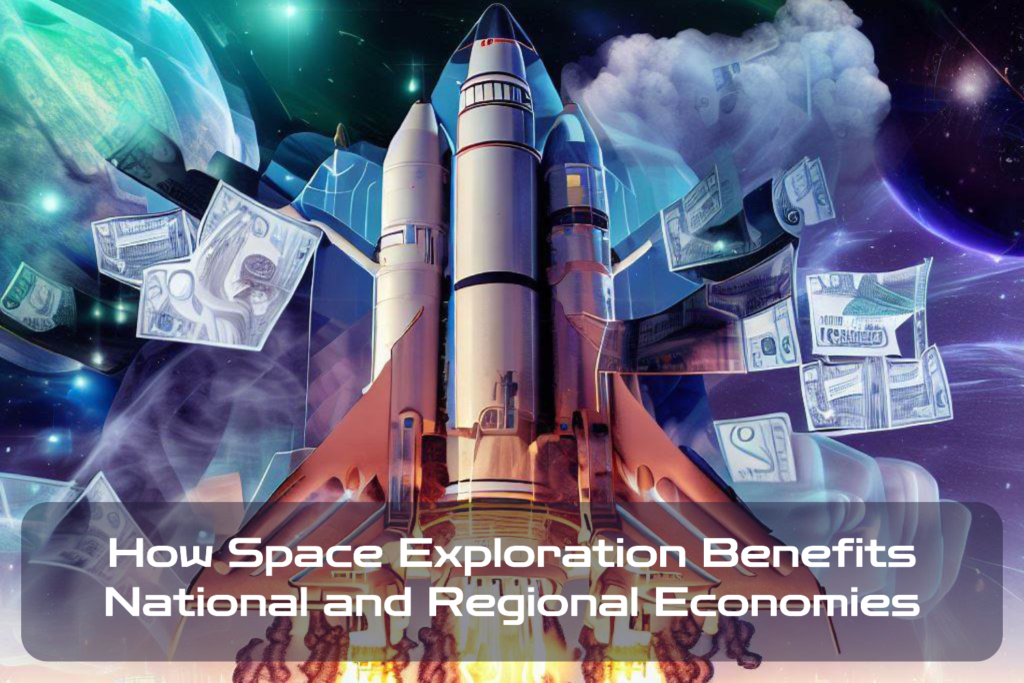A Universe of Opportunity: The Importance of Space Exploration
When we think of space exploration, we may picture astronauts floating around in zero-gravity or rovers driving across the barren Martian landscape. However, space exploration has much broader implications for our society than simply expanding our understanding of the universe. It also has significant economic benefits for both national and regional development.
One reason for this is that space exploration provides important technological advancements that have spin-off applications in other industries.
For example, NASA’s work on developing lightweight materials and fuel-efficient engines has led to advances in transportation and energy production on Earth.
Additionally, the development of new technologies like satellite imaging has revolutionized global communication and transportation networks.
Furthermore, space exploration creates jobs and workforce development opportunities across a range of sectors.
From engineers to scientists to support staff, space agencies require a diverse array of skills to operate effectively. This not only creates jobs directly related to space exploration but also stimulates growth in related industries as well.
Reaching for the Stars: National Economic Benefits
The economic benefits of space exploration are significant at the national level as well. One key benefit is increased competitiveness in the global market through technological innovation developed during space missions.
For example, NASA’s robotic technology developed during Mars missions led to new innovations in medical imaging equipment.
Furthermore, public-private partnerships between governments and private companies can stimulate economic growth through investment in research and development projects related to space technology. These partnerships can lead to commercialization opportunities for businesses both within and outside the aerospace industry.
Another important aspect is job creation within the industry itself, as many people are employed by government agencies or private companies involved with designing spacecraft or launching them into orbit. Through partnerships with other nations on peaceful initiatives such as the International Space Station (ISS) there are enormous opportunities available for nations to benefit economically in many ways from space exploration.
National Economic Benefits

Job creation and workforce development in the space industry
The space industry has created numerous job opportunities for people all around the world.
From engineers and scientists to technicians and operations staff, the range of positions available is diverse. These jobs provide high salaries, attract talented individuals, and contribute positively to the economy.
Furthermore, these jobs lead to workforce development as new skills are required for space exploration.
For instance, aeronautics engineers need to develop innovative methods of propulsion that can make space travel more efficient.
Materials scientists need to come up with new materials that can withstand extreme conditions in space. Similarly, technicians need to learn how to operate advanced equipment used in spacecraft assembly.
Technological advancements and spin-off technologies for other industries
The technology developed for space exploration has numerous applications beyond just aerospace engineering.
Satellites developed for communication purposes have led to advances in
- weather prediction systems,
- GPS tracking technology,
- and satellite imagery used in various fields like agriculture.
In addition, NASA developed miniaturized electronic components that were shock-resistant and lightweight, which were later used by companies such as Apple to create modern-day consumer electronics like laptops and smartphones.
Increased national competitiveness globally
Space exploration is an expensive endeavor, but it pays off by making countries more competitive on a global scale, both economically and technologically.
Countries that invest heavily in their space programs gain recognition on an international level as pioneers of technological innovation. This recognition not only leads to a greater sense of national pride but also attracts foreign investment from multinational corporations interested in collaborating with local companies developing cutting-edge technologies, thus boosting exports, which results in economic growth.
Economic growth through public-private partnerships
Public-private partnerships (PPP) bring together private sector businesses and government agencies working collaboratively towards achieving specific goals, such as developing new technologies or funding scientific research projects.
PPPs can help to pay for the high costs of space exploration by sharing the risks and benefits of such initiatives.
Furthermore, PPPs can lead to the commercialization of space technology resulting in new businesses and job opportunities.
Companies like SpaceX have worked with NASA on multiple projects, including transporting astronauts to the International Space Station, in addition to launching satellites for private companies. These partnerships have made it possible for SpaceX to become a leader in commercial space travel while also contributing positively to economic growth through job creation.
Regional Economic Benefits

Development of local economies through space-related industries
When we talk about the economic benefits of space exploration, we often focus on the national level. But what about the impact on local economies?
The development of space-related industries can have a significant impact on the economy of a region, creating jobs and stimulating growth. One example is Florida’s Space Coast, which has been home to NASA’s Kennedy Space Center since the 1960s.
The region has seen significant economic growth thanks to the presence of the space industry, with companies like SpaceX and Blue Origin now calling it home. In addition to job creation in manufacturing and engineering, there are also opportunities in areas like hospitality and retail as more tourists visit the area.
Attraction of high-tech companies to regions with established space industry presence
The presence of a thriving space industry can also attract other high-tech companies to set up shop in a region. These companies may not be directly involved in space exploration themselves but can benefit from access to talent and resources that are already present.
For example, Silicon Valley has long been associated with the tech industry but is also home to NASA’s Ames Research Center. This proximity has allowed for collaboration between both industries, leading to technological advancements such as improved sensors used for drone navigation.
Increased tourism opportunities through space-related attractions
Space-related attractions can also draw tourists and provide an additional source of revenue for a region’s economy. Tourists may be interested in visiting museums showcasing historic missions or taking tours of current launch facilities. One noteworthy example is Space Center Houston which receives over 1 million visitors annually from all around the world eager to learn more about human spaceflight history and experience astronaut training simulations.
Regional economic benefits are another important aspect when considering investments in developing space technologies, as they have the potential for job creation, increased investment, and growth in local communities. Regions with an established space industry presence have seen significant economic growth, leading to increased tourism opportunities and the attraction of other high-tech companies to the region.
Small Business Opportunities

Access to government contracts and funding for small businesses in the space industry
Small businesses in the space industry can access a variety of government contracts and funding opportunities. These opportunities are often provided by NASA, but other government agencies also offer them. For example, the Small Business Innovation Research (SBIR) program is a competitive program that provides funding to small businesses for research and development projects.
The program is open to all industries, including the space industry. To qualify for government contracts and funding, small businesses must meet certain requirements.
They must be registered with the System for Award Management (SAM) and have a DUNS number. They must also be able to demonstrate their capability to perform on a government contract.
Opportunities for innovation and entrepreneurship in the commercialization of space technology
The commercialization of space technology offers many opportunities for innovation and entrepreneurship. Space exploration requires new technologies that can withstand harsh conditions, such as extreme temperatures and radiation exposure.
These technologies often have applications outside of the space industry.
For example, GPS technology was originally developed by the US military for use in navigation systems on fighter jets, but it has since been commercialized for use in smartphones and other consumer electronics.
This type of spin-off technology creates new business opportunities beyond just those directly related to space exploration.
Another example is SpaceX’s reusable rocket technology, which has drastically reduced the cost of launching payloads into orbit.
This has made it possible for more companies to enter the satellite market, creating new business opportunities in areas such as remote sensing and telecommunications. Innovation and entrepreneurship are critical components of economic growth, making this area particularly exciting for small businesses looking to expand their footprint.
The importance of public-private partnerships
Public-private partnerships are crucial in promoting economic growth through space exploration. Governments provide funding support while private companies bring technological innovation and expertise. This collaboration creates a synergistic relationship that benefits both parties.
For example, NASA has developed partnerships with several private companies for crewed spaceflight programs. These include SpaceX and Boeing, among others.
By working together, these companies can share resources and knowledge to achieve common goals. Small businesses can also take advantage of public-private partnerships.
These partnerships often provide access to funding opportunities as well as mentorship and networking opportunities. This can be particularly valuable for small businesses that are just starting out in the industry.
Overall, small businesses have many opportunities in the space industry, from accessing government contracts to commercializing spin-off technologies. Public-private partnerships are critical in promoting economic growth through space exploration and offer even more exciting possibilities for small businesses looking to innovate and grow.
International Collaboration

Sharing Resources, Knowledge and Technology
Space exploration is not limited to the boundaries of a single country, but rather is a global endeavor. International collaboration within the space industry has led to shared resources, knowledge, and technology that have been developed and tested by various countries over the years.
These collaborations have allowed for joint missions with astronauts from different countries working together on scientific research that benefits all humans living on Earth. The International Space Station (ISS) is one of the most notable examples of successful international collaboration in space exploration.
The ISS, launched in 1998, is a joint project between five space agencies:
- NASA (US),
- Roscosmos (Russia),
- JAXA (Japan),
- ESA (Europe)
- and CSA (Canada).
The collaborative partnership allows for shared expenses and risks while also providing multinational crews with an opportunity to live and work in space.
Diplomatic Benefits Through International Cooperation on Peaceful Exploration Initiatives
International cooperation in space exploration can also bring about diplomatic benefits. Collaborative efforts for peaceful exploration initiatives can build trust among nations, leading to stronger diplomatic ties, which can be beneficial for resolving disputes or opening new opportunities for trade.
One example of this was demonstrated during the Cold War when tensions were high between the United States and the Soviet Union.
However, both nations worked together during the Apollo-Soyuz Test Project in 1975 where they docked their spacecrafts together while orbiting Earth. Today, international cooperation continues as a way to advance scientific discovery while building goodwill between nations.
One example is NASA’s partnership with China’s National Space Administration (CNSA). In 2019, NASA invited CNSA engineers to visit their facilities in Houston, where they exchanged knowledge on human deep-space exploration, leading to increased collaboration between the US-China’s space programs.
Final Thoughts

Given all these incredible potential benefits of space exploration for both national and regional economies around the world, it is clear that continued investment in this field must be a priority. As we have seen above, there are numerous direct and indirect ways in which this investment can pay off – from new jobs being created to technological advancements driving progress across multiple industries. Of course, investing in such ambitious projects is not cheap – but it’s important not to lose sight of what’s at stake here.
The potential returns on this kind of investment could be truly enormous – not just financially but also socially and culturally.

C M, a seasoned editor, journalist, and consultant, is deeply fascinated by the convergence of technology, space, and the future of humanity.
With a particular interest in transhumanity, futurology, and the philosophical and ethical dimensions of these domains, C M serves as the lead contributor to SpaceSpotlight and TranscendSphere.
When not penning insightful articles on these rapidly evolving fields, C M indulges in their love for podcasts and books, proudly embracing their status as a ‘Happy Nerd Extraordinaire!’



